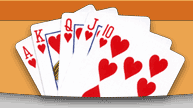Strategies for Caribbean Stud, Let
It Ride, and Three Card Poker
Upon arriving at the office one day, I found
the message light blinking away. A reader wanted to talk strategy.
"You have your strategy for this game and your strategy for
that game, but is all that really necessary?" he wanted to
know. "No
doubt your way is better, but it's all luck in the end, isn't
it? Is the few bucks here and few bucks there I save worth all
the
time it takes to memorize one of those strategies?"
In my view it is, or I wouldn't be writing this column. Let's
say I play basic strategy at blackjack, and you mimic the dealer,
hitting
or standing by dealer's rules. In the long run, I can expect
to lose about 50 cents per $100 wagered–a little more or less,
depending
on house rules. You can expect to lose about $5.70 per $100
wagered–more than 11 times my expected losses.
Or let's say we're playing Caribbean Stud Poker. With basic
strategy for deciding when to fold and when to make the bet
of double
the ante, I can expect to lose about $5.23 for every $100
wagered. If you want to just bet on every hand and trust to
luck, as
I've seen players do, your losses will average about $16.60
per $100
anted.
Yes, basic strategies make a difference and are worth the
time to master if you plan to play for money.
From time to time over the next couple of months, I'm going
to go over basic strategies for a number of casino table
games, followed by a few popular video poker variations.
Let's start
with three
games that are based on stud poker–Caribbean Stud, Let
It Ride
and Three Card Poker. Caribbean Stud
The most widespread of the new table games that rose
to popularity in the 1990s, Caribbean Stud gives
the player just one strategy decision to make: After
seeing his or her five-card hand, the player must
decide whether to fold or to place a bet of twice
the ante. With proper basic strategy, the player
lowers the house edge on the game to 5.23 percent
of the ante.
The player should bet if the hand meets any of the
following conditions:
- A pair or better.
- Both an Ace and a King, and one
of the other three cards matches the dealer's face-up
card.
- Ace-King-Queen or Ace-King-Jack, and any of
the five cards matches the dealer's up card.
- Ace-King-Queen
and the player's next highest card outranks the
dealer's up card.
Players seem to have the most
trouble with the second and third conditions, with
the requirement that they
match the dealer's up card. The reason for that
requirement is that the matching card in your hand
decreases
the likelihood that the dealer will have a pair
that will
beat your Ace-King.
Let It Ride
In Let It Ride, the player makes three bets, two
of which may be pulled back. There is no dealer's
hand
to beat. The player is just betting that his or her
final hand will make it to a pay table that starts
at a pair of 10s.
There are two strategy decisions to make. After seeing
three cards, the player may choose to pull back the
first bet. After seeing the fourth card, the player
may choose to pull back the second bet. Bet No. 3
must stay in action, and all remaining bets are decided
after players see their fifth cards. Basic strategy
leaves a house edge of 3.5 percent.
After seeing the first three cards, leave bets in
action with the following hands:
- Any paying hand--a pair of 10s or better.
- hree
consecutive cards of the same suit, ranking 3-4-5
or higher. That gives us potential flushes,
straights or straight flushes.
- Three cards of the same suit with one gap, provided
they include at least one card that is a 10
or higher. For example, we hold 7-8-10 of the same suit, but not
6-7-9, because along with the potential straights
and flushes, the 10 gives us the possibility of finishing
with a high pair payoff.
- Three cards of the
same suit with two gaps, provided they include
at least two cards that are 10
or higher. We keep 8-Jack-Queen, but not 8-9-Queen.
Three Card Poker
This is the easiest game of all. Three Card Poker
is really two games in one. One part, called
Pair Plus,
is a simple bet that the player's three-card
hand will include a pair or better. There is no
strategy to this
portion of the game; just make your bet and
wait to see if you win.
The other portion is play against the dealer,
similar to Caribbean Stud. After seeing his
or her cards,
the player must decide whether to fold or place
a bet equal
to the original ante. The house edge is 2.0
percent of the ante, or 3.4 percent of total
action,
with one simple strategy rule: Bet with Queen-6-4
or
better, fold with anything less.
|









